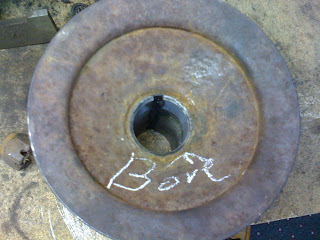Came back the next day (Saturday) to be joined by a couple of my Okie car friends who took nearly everything else, save for a piece or two I picked out before they arrived. It was, as you can expect, a bittersweet event: getting all kinds of cool stuff that hasn't seen the light of day in decades, but all the while knowing this man is being forced out of business, and the cool old steel building in which he did business will soon be gone...
While these pictures by no means cover all that I got, here's some snaps of the highlights:
Pair of Johnson adjustable tappet (lifter) wrenches (for the flathead)

Set of Ford valve guide remover tools; top to bottom: V-8 valve spring compressor; A & B (2); V-8; V-8 (by Plomb, #6521)

And some more Plomb tools

Pair of Model A axle housings, converted into axle stands, for Model A and early Ford V-8 era rear axles. At my friend's suggestion , I'm going to cut off the spring mounts and mount them on top of my 1939 axle housings, rather than use the Pete & Jake spring mounts. My friend has sneered at the P&J ones since he first saw them, and has continually suggested this solution, which he insisted guys did back then...maybe, but if it works and looks better, who cares? After I cut off the spring mounts, I can still use them as stands, so...

A VERY cool tach with an odometer(!). THIS is the solution to my speedometer/tachometer quandary that I was facing with the T, not to mention trying to find something that looked "period" (circa 1950 or so). Now I can run one gauge, driven off the speedo cable, and have an odometer, too. The stamping and numbering on the back lead me to believe this is Stewart-Warner, but no name appears on the case. This thing looks beautiful, PLUS it's got right angle drive!


And finally, for the pièce de résistance, a Sun 504 distributor tester and rolling cart. Complete with a giant Sun-labeled can of automotive spec sheets from 1964 to 1973 or so, AND all the adaptors, including those for magnetic pickup distributors, AND Ford flathead distributors!

To close out the photos, here's the back of the pickup with all my stuff, plus the United Motors Service sign my uncle got, but I delivered. (A small price to pay for the lead!)

I'll post more photos next week, when I pick up the last couple items, including a Snap-On battery charger.
Until then,
-30-



















